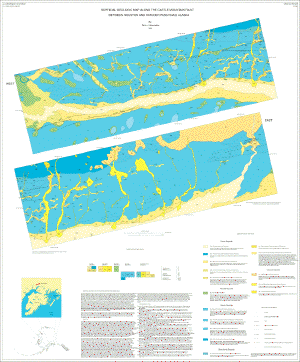 Summary Summary
The surficial geology of the map area is dominated by sedimentary deposits laid down during and after the Naptowne glaciation (Karlstrom, 1964) of late Pleistocene age. During this episode, a large valley glacier flowed westward down the Matanuska Valley along the southern flank of the Talkeetna Mountains. The youngest of two documented advances has been referred to as the Elmendorf stade, which reached its maximum extent about 12,000 radiocarbon years ago (Schmoll and others, 1972; Reger and Updike, 1983). Deposits from this stade in the map area include: glacial till (Qg), lateral moraine (Qml) and kame terrace (Qk) deposits. Older episodes of glaciation have been inferred by a number of workers (e.g., Karlstrom, 1964; Reger and Updike, 1983; Reger and Updike, 1989; Schmoll and Yehle, 1986). The ridge above and north of the map area, Bald Mountain Ridge, is rounded in contrast to higher areas of the Talkeetna Mountains to the east. Therefore, within the map area older glacial deposits (Qg2) are inferred to lie above the highest Naptowne deposits. After reaching its maximum extent the valley glacier stagnated (Reger and Updike, 1983), as indicated by a crevasse-fill-ridge complex south of Houston in the map area, perched drainages along the sides of the Talkeetna Mountains, and an esker (unit Qe in the middle of the western map area). The ancient stream deposits (unit Qad) are perched on the southern flanks of the Talkeetna Mountains and were deposited by westward flowing streams as the valley glacier stagnated. These sinuous ancient drainages commonly incised up to 20 m into the underlying glacial till. Because stream flow is not as high today as when the drainages formed, the modern streams flowing within these drainages are underfit, and the ancient drainage courses are commonly filled with peat deposits (Qp).
After ice of the Elmendorf stade melted, modern stream courses were established. These include the southward flowing streams on the flank of the Talkeetna Mountains as well as the west-southwestward flowing Little Susitna River. The Little Susitna River cut down through older river terrace deposits (Qat) to form the active alluvial plain (Qaa). Alluvium from the southward flowing streams (Qas) forms alluvial fans on top of, and presumably interfingering with, active alluvium along the Little Susitna River.
|
First posted May 27, 2003
Surficial Geology
Faults
Topography and Culture
Plot files of entire map
Part or all of this report is presented in Portable Document Format (PDF). For best results viewing and printing PDF documents, it is recommended that you download the documents to your computer and open them with Adobe Reader. PDF documents opened from your browser may not display or print as intended. Download the latest version of Adobe Reader, free of charge.
|